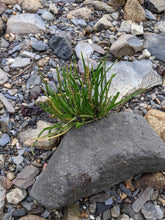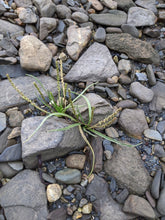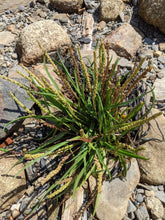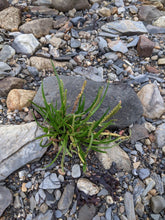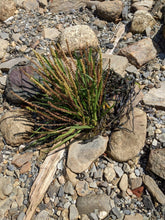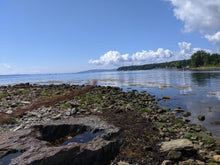'Searsport' Sea Plantain
Regular price
$4.25
Sale
Plantago maritima
Origin: Searsport, Maine
Improvement status: Wild
Seeds per packet: ~40
BOTANICAL SAMPLE - NOT GERMINATION TESTED
Life cycle: Perennial
EFN INTRODUCTION. I get excited about a lot of plants, but few plants have lit my fire as much as this one, and it's a real thrill to have enough seed to share some with all of you.
Sea Plantain (Plantago maritima) is a wild perennial vegetable that inhabits maritime environments in temperate to cold climates. It's so resilient it can thrive well below the high-tide line, getting swamped by seawater for multiple hours twice a day. It can handle essentially being watered with saltwater. It also has a similar nutritional and medicinal profile to the other plantains, which means it's a powerhouse. But the best thing about it is its quality as food.
I've put a lot of plantain in my mouth through the years — especially the common wild types, Plantago major and Plantago lanceolata, which I often chew up and apply to insect bites or other skin irritations — but I'd never had any that tasted as fantastic as the population of sea plantain I found growing in Searsport, Maine, one day in the summer of 2021 (while visiting the wonderfully seedy couple Eli Rogosa and Cr Lawn). Crunchy, fleshy, salty, fresh, and vibrant, it's easy to start munching on this plant by the handful. There's really nothing like it. And while I only ate it raw then, I now know it can be cooked or pickled too. Some plants have a bit of bitterness, but not most of them. And none were as bitter as the buckshorn plantain (Plantago coronopus) that people regularly grow in gardens as food. What's more, the fleshy leaves of this species can stay crunchy and delicious without refrigeration for 4 or 5 days after harvest — a remarkable quality in any vegetable, but especially one used as a green.
I'd been hoping to find these plants — which grow on seashores around the world, including both coasts of North America — one day, but to find them with ripe seeds too, and on such good-tasting plants, I couldn't have asked for more. (I found some in Iceland a few months later, but almost all of the plants were rather bitter. And I've since found many more populations in Maine and one in Washington state, the seeds of all of which are now available in the catalogue too.)
This perennial wild plant has huge potential as a perennial vegetable. Beyond being nutritious, delicious, and easy to grow (if you can keep the rabbits at bay!), it can also grow in saline soils, which the world has lots of these days due to both over-irrigation and seawater incursion (both exacerbated by climate change).
By putting these seeds out into the world, we're hoping to start a collaborative domestication project that I firmly believe could result in the best-tasting perennial green in the world.
Who's in?
(To stay in touch on this effort, please sign up and join this project at www.ExperimentalFarmNetwork.org)







